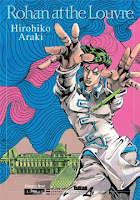 Creator: Hirohiko Araki
Creator: Hirohiko Araki
U.S. publisher: NBM Publishing
ISBN: 9781561636150
Released: February 2012
Original release: 2010
I was very excited when NBM Publishing announced the 2012 release of the English edition of Rohan at the Louvre by Hirohiko Araki. Originally published in 2010 in French and Japanese, Rohan at the Louvre is a part of the “Louvre Collection,” a series of individual graphic novels commissioned by the Louvre that feature the museum and its collections as part of the story. The effort is meant to bridge the gap between the comics world and the museum world, showing readers and visitors the artistic merits of each. Rohan at the Louvre is the fifth graphic novel, and the first manga, to be included in the series. Rohan is a character from Araki’s manga JoJo’s Bizarre Adventure, who is first introduced in the series’ fourth part, Diamond is Unbreakable. (Unfortunately, this arc hasn’t been licensed in English.) Since then, Rohan has continued to appear in a number of stand alone works, such as Rohan at the Louvre, as well as in other JoJo’s Bizarre Adventure side stories and spin-offs.
Rohan Kishibe has an ability known as “Heaven’s Door” which allows him to manipulate memories and read a person like the pages of a book, both literally and figuratively. While he was seventeen and still trying to break into the industry as a mangaka, he meets a troubled young woman named Nanase. After taking an interest in his art, she tells him a story about the darkest, most evil painting to have ever been created. Ten years later Rohan has become a successful and world famous artist. One day he is reminded of Nanase’s story. Following the rumor to Paris and the Louvre Museum, Rohan hopes to catch a glimpse of the mysterious painting or to at least establish if it even exists. What he discovers at the museum is not at all what he was expecting to find. The resulting incident leaves four people missing and Rohan shaken, the only person left to tell the tale.
I adore Araki’s artwork in Rohan at the Louvre. Unlike most manga, Rohan at the Louvre is completely in color. In fact, it’s the occasional lack of color, or when Araki switches to grey, that especially draws the readers’ attention to a particular panel or page element. Araki primarily uses three major color palettes for the three different parts of the story: Rohan’s memories of his youth, his journey to the Louvre, and his search for the mysterious painting. Araki’s striking color work is marvelously effective, adding another level to his artistry. While the color emphasizes the fantastic, Araki’s line and figure work tends toward the realistic, creating an interesting and engaging contrast. His faces in particular, with their dark eyelashes and full lips, are beautiful. Fairly frequently the characters seem to be posed rather than falling naturally into their positions, but at the same time the resulting images are sensual and arresting. Araki’s illustrations are meant to be looked at and appreciated not just as part of the story but as art.
Although I didn’t find the story of Rohan at the Louvre to be quite as strong as its artwork, I still enjoyed it a great deal. The narrative starts out well but the ending seems to tie everything up a little too nicely and easily after all hell breaks loose. Still, I can’t say I didn’t like it because I did. I particularly enjoyed seeing the changes in Rohan’s characterization at different ages. As a seventeen-year-old he is still young and impressionable as well as slightly self-conscious while at twenty-seven he is significantly more arrogant, sure of himself, and wiser to the world. I like Rohan and I like the story he tells. The translation does occasionally come across as awkward—I would find myself having to puzzle over small sections and there is a particularly disruptive typo towards the end of the book—but overall it doesn’t detract too much from the manga as a whole. I am very glad that I picked up Rohan at the Louvre; I have already reread the volume several times. The artwork is phenomenal and the lead is both engaging and intriguing.
[…] that was available in English was the third story arc, Stardust Crusaders. A standalone side story, Rohan at the Louvre was released as well, but it wasn’t until 2015 that the very beginning of the series, Phantom […]